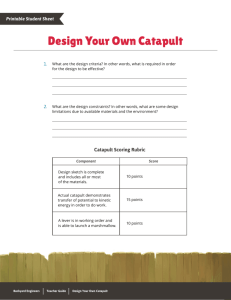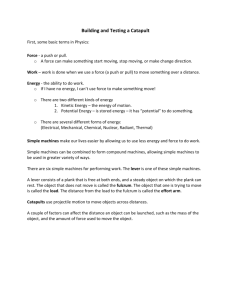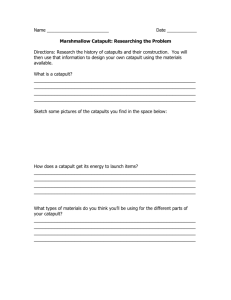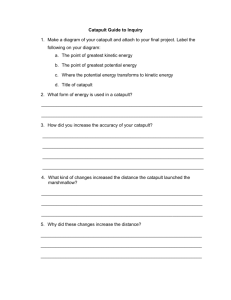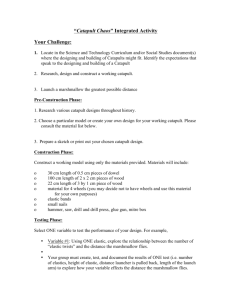Marshmallow Catapult: Physics Worksheet for Middle School
advertisement
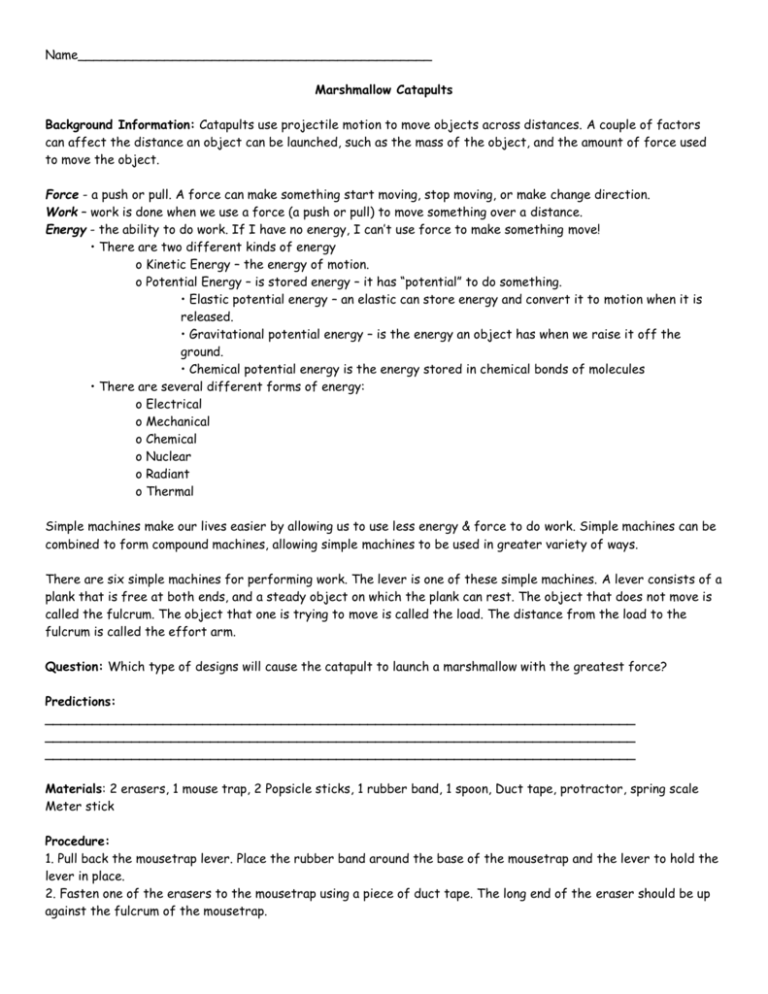
Name_____________________________________________ Marshmallow Catapults Background Information: Catapults use projectile motion to move objects across distances. A couple of factors can affect the distance an object can be launched, such as the mass of the object, and the amount of force used to move the object. Force - a push or pull. A force can make something start moving, stop moving, or make change direction. Work – work is done when we use a force (a push or pull) to move something over a distance. Energy - the ability to do work. If I have no energy, I can’t use force to make something move! • There are two different kinds of energy o Kinetic Energy – the energy of motion. o Potential Energy – is stored energy – it has “potential” to do something. • Elastic potential energy – an elastic can store energy and convert it to motion when it is released. • Gravitational potential energy – is the energy an object has when we raise it off the ground. • Chemical potential energy is the energy stored in chemical bonds of molecules • There are several different forms of energy: o Electrical o Mechanical o Chemical o Nuclear o Radiant o Thermal Simple machines make our lives easier by allowing us to use less energy & force to do work. Simple machines can be combined to form compound machines, allowing simple machines to be used in greater variety of ways. There are six simple machines for performing work. The lever is one of these simple machines. A lever consists of a plank that is free at both ends, and a steady object on which the plank can rest. The object that does not move is called the fulcrum. The object that one is trying to move is called the load. The distance from the load to the fulcrum is called the effort arm. Question: Which type of designs will cause the catapult to launch a marshmallow with the greatest force? Predictions: ___________________________________________________________________________ ___________________________________________________________________________ ___________________________________________________________________________ Materials: 2 erasers, 1 mouse trap, 2 Popsicle sticks, 1 rubber band, 1 spoon, Duct tape, protractor, spring scale Meter stick Procedure: 1. Pull back the mousetrap lever. Place the rubber band around the base of the mousetrap and the lever to hold the lever in place. 2. Fasten one of the erasers to the mousetrap using a piece of duct tape. The long end of the eraser should be up against the fulcrum of the mousetrap. 3. Tape a second eraser on top of the first eraser so that the second eraser is slightly over the fulcrum. Place tape around both of the erasers. 4. Carefully remove the rubber band from the lever, and slowly bring it to stand next to the erasers. 5. Tape one of the Popsicle sticks to the lever so that it is perpendicular with the lever. This will support the catapult arm. 6. Tape another Popsicle stick to the lever so that it is parallel with the lever. This will extend the arm of your catapult. 7. On the end of the second Popsicle stick, rubber band or tape your plastic spoon. 8. Your catapult is ready for use! When using the catapult, always make sure to hold down the base. 9. Measure for maximum distance, and then use a cup as a target for accuracy. Data: Make a data chart to record your observations: Conclusion: 1. Make a diagram of your catapult below. Label: a. the point of greatest kinetic energy b. the point of greatest potential energy c. where potential energy transforms to kinetic energy 2. What form of energy is used in a catapult? 3. How does the catapult demonstrate the laws of motion? 1st law ___________________________________________________________________________ ___________________________________________________________________________ 2nd law ___________________________________________________________________________ ___________________________________________________________________________ 3rd law ___________________________________________________________________________ ___________________________________________________________________________ 4. How did you increase the accuracy of your catapult? ___________________________________________________________________________ ___________________________________________________________________________ 5. What kind of changes increased the distance the catapult launched the marshmallow? ___________________________________________________________________________ ___________________________________________________________________________ 6. WHY did these changes increase the distance? ___________________________________________________________________________ ___________________________________________________________________________ 7. Do a little math Your catapult is a simple machine, a lever. In moving a marshmallow your catapult is doing work. Identify the class of lever your catapult falls in. Calculate the work being done by your catapult and the mechanical advantage of your machine. My Catapult is a _____ Class Lever MA = Effort arm length / Resistance arm length Length of effort arm _________________ cm. Length of resistance arm ______________ cm. Mechanical Advantage ______________ Work = Force x Distance Force ________ N. Distance _________ m. Work _________ Adapted from activities at http://www.life.uiuc.edu/boast1/sciencelessons/levers.htm and http://www.usoe.k12.ut.us/curr/Science/sciber00/8th/machines/sciber/cat.htm
